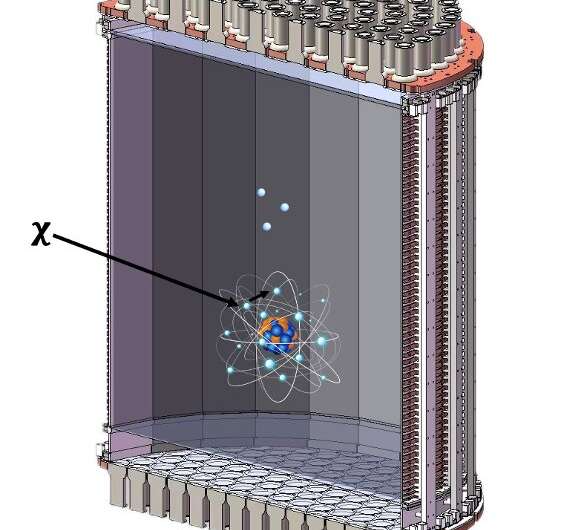July 19, 2023 feature
This article has been reviewed according to Science X's editorial process and policies. Editors have highlighted the following attributes while ensuring the content's credibility:
fact-checked
peer-reviewed publication
trusted source
proofread
PandaX sets new constraints on the search for light dark matter via ionization signals

Teams of physicists worldwide have been trying to detect dark matter, an elusive type of matter that does not emit, absorb, or reflect light. Due to its lack of interactions with electromagnetic forces, this matter is very difficult to observe directly, thus most researchers are instead searching for signals originating from its interactions with other particles in its surroundings.
The PandaX experiment is a research effort dedicated to the search of dark matter using data collected by the Particle and Astrophysical xenon detector, situated at the China Jinping Underground Laboratory (CJPL) in Sichuan, in China. In a recent paper published in Physical Review Letters, the researchers involved in this large-scale experiment published the results of their most recent search for light dark matter (i.e., weakly interacting massive particles with masses below 1 GeV).
"Currently, strong constraints exist for heavy mass dark matter candidates derived from null results in direct detection experiments using xenon detectors," Yue Meng, Qing Lin and Ning Zhou told Tech Xplore, on behalf of the PandaX collaboration. "However, traditional searches are not sensitive to light mass dark matter (less than GeV/c2) due to the detection energy threshold. Using an ionization-only signal (S2-only) to search for light mass dark matter can reduce the energy threshold from ~1 keV to 0.1 keV. Previous S2-only data analyses in xenon detectors were unable to model the background, which prevented effective and sensitive searches for light mass dark matter."
In dual-phase xenon detectors, like the PandaX detector, dark matter could typically manifest itself via a prompt scintillation signals (S1) and an ionization signal (S2). To reduce the threshold energy at which this signal could be detected, Meng, Lin, Zhou and their colleagues focused on the second of these signals (S2), the so-called ionization signal, which would occur when electrons are ionized from xenon atoms, and then extracted from liquid xenon under an electric field.
"We focused on ionization-only data, as the ionization signal S2 is amplified in the high electric field in the gas xenon region, and relaxed the requirement of S1," the researchers explained. "During the PandaX-4T commissioning run, approximately 90 days of data were collected. We first unblinded the control region to validate our background estimation, then unblinded the signal region for the light mass dark matter signal test. Ultimately, no significant excess was observed, and we derived constraints for light dark matter particles."
While this recent work by the PandaX collaboration did not yield the observation of signals hinting at the presence of light dark matter, it allowed the researchers to set more stringent constraints on the detection of this type of dark matter by searching for ionization signals. These constraints delineate a mass range from 40 MeV/c2 to 10 GeV/c2 for point-like dark matter-electron interaction, 100 MeV/c2 to 10 GeV/c2 for dark matter-electron interaction via a light mediator, and 3.2 to 4 GeV/c2 for dark matter-nucleon spin-independent interaction.
"This is the first time that ionization-only backgrounds have been understood and modeled in modern liquid xenon time projection chambers with few-electron level energy threshold," Meng, Lin and Zhou said. "The results provide the most stringent constraints yet on potential interactions for dark matter particles across mass ranges as broad as about 40 MeV/c2 to 10 GeV/c2, depending on the type of interaction. The new limits are closing in on the parameter space that researchers predict dark matter particles produced by freeze-in and freeze-out mechanisms in the early universe may inhabit."
The new constraints set by the PandaX collaboration could inform new searches for light dark matter using data collected by dual-phase xenon detectors. Meanwhile, the PandaX detector is gathering more data with lowered background level, which could help to set increasingly stringent constraints on light dark matter, potentially contributing to its future detection.
"The PandaX-4T experiment is continuing to collect data and improve the sensitivity of its search," Meng, Lin and Zhou added. "Based on our improved understanding of S2-only background, we plan to further suppress it by developing better discrimination algorithm with more collected data and/or optimizing the running condition to suppress the origins of such backgrounds."
More information: Shuaijie Li et al, Search for Light Dark Matter with Ionization Signals in the PandaX-4T Experiment, Physical Review Letters (2023). DOI: 10.1103/PhysRevLett.130.261001
Journal information: Physical Review Letters
© 2023 Science X Network





















